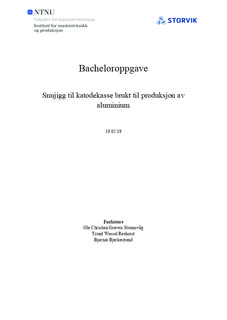Snujigg til katodekasse brukt til produksjon av aluminium
| dc.contributor.advisor | Olsen, Anna | |
| dc.contributor.author | Strømsvåg, Ole Christian Graven | |
| dc.contributor.author | Reehorst, Trond Wessel | |
| dc.contributor.author | Bjerkestrand, Bjørnar | |
| dc.date.accessioned | 2019-09-06T14:05:11Z | |
| dc.date.available | 2019-09-06T14:05:11Z | |
| dc.date.issued | 2019 | |
| dc.identifier.uri | http://hdl.handle.net/11250/2613412 | |
| dc.description.abstract | Formålet med denne oppgaven var å utvikle en snu-jigg for å gi Storvik AS mulighet til å utføre vedlikehold på katodekasser som fungerer som elektrolyseceller i fremstillingen av aluminium. Slik de står i dag utføres det minimalt vedlikehold på undersiden av kassene. Løsningen som designes skal kunne heve katodekassen, for så å rotere den i ønsket vinkel. Et ønske fra Storvik AS var at innretningen skal kunne rotere katodekassen minimum 270 grader. Dette vil føre til at vedlikehold kan utføres på begge sider og på undersiden av kassen, samtidig muliggjør dette en mye bedre arbeidsstilling og legger til rette for bruk av sveiserobot. Dette har vi gjort ved å ta i bruk SolidWorks til utforming og design av snujiggen. Vi har også brukt SolidWorks og håndberegninger til å finne de rammebetingelsene som gjelder for vårt design. Gjennom rammebetingelsene har vi funnet hvordan kreftene forplanter seg gjennom snujiggen. Prosessen har vaert å ta for oss de individuelle delene og designe dem, for så å kjøre en styrkeberegning. Dette for å sikre riktig utforming av de individuelle delene og at de distribuerer kreftene på en sunn måte. Det vi fant var at de individuelle delene tåler de påkjenningene gitt fra katodekassen med god margin. Simulering av snu-jiggen peker på at de parameterne gitt til SolidWorks ikke er gode nok. Dette fører til at de resultateten som simuleringene gir oppfattes som urealistiske. Optimalisering av snu-jiggen settes derfor til kapittel «7.1 Veien videre». | |
| dc.description.abstract | The purpose of this report was to develop a solution for Storvik AS to carry out safe maintenance of their cathode pot which is the electrolyze cell in the process of making aluminum. Today, they are not able to carry out proper maintenance on the bottom of the cathode pots. The solution we designed will be able to lift the pot and then rotate it to the desired angle, which is 270 degrees. The implementation of the turning jig to the pot means that Storvik AS will be able to perform maintenance on both sides as well as the bottom of the pot. In addition, a better ergonomic working position, and allows the work to be performed with a robot welder. To solve this problem, we used SolidWorks to design and develop the turning jig. SolidWorks, as well as hand calculations, was used to calculate the forces that affects the jig. Hand calculation of the forces have been performed to be able to execute the simulations in SolidWorks. From the simulations we have been able to understand how the forces propagate and the impact they have on the construction. The calculations done by hand has been a central part, as the results has given us the forces necessary for the simulations in SolidWorks, to see how these forces propagate further in the mechanism. Our process has been to address the individual parts and design them, then run a force calculation. This is to ensure the correct design of the individual parts and that they distribute the forces in a healthy way, then create a full composition in SolidWorks and run simulation on the whole turning jig. We conclude that the individual parts do withstand the stresses given from the cathode pot by a good margin. The simulations of the assembly do give a different result entirely. It shows that the limits, like fasteners and forces applied, in SolidWorks is not applied correctly, or so we can assume. This gives us a result that we perceive as unrealistic. Optimization of the turning jig is therefore listed under chapter “7.1 Veien videre”. | |
| dc.language | nob | |
| dc.publisher | NTNU | |
| dc.title | Snujigg til katodekasse brukt til produksjon av aluminium | |
| dc.type | Bachelor thesis |
